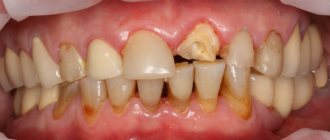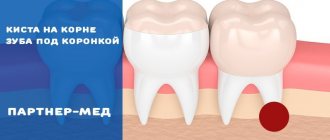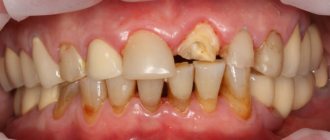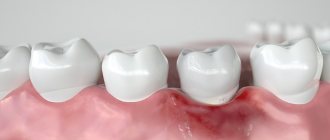From this article you will learn:
- why does the tooth under the crown hurt,
- what causes inflammation of the gums under the crown,
- how to treat a tooth under a crown.
There are only a few reasons why a tooth hurts under a crown. And almost all of them are associated exclusively with poor preparation of the tooth for prosthetics, i.e. with poor quality root canal filling. And here, if we look at the official statistics in dentistry, we will see that root canals are filled by dentists with poor quality even in more than 60-70% of cases. However, there are several other much less common causes.
For example, inflammation of the tooth under the crown, pain when biting and swelling of the gums can also occur in cases where living (not pulpless) teeth were taken under the crowns. In this case, the development of inflammation will not be associated with poorly filled root canals, but with a thermal burn of the pulp caused by the dentist during the process of grinding the tooth for a crown. In this case, one, several months or a year after prosthetics, the patient may first feel pain or other symptoms of inflammation.
As a rule, a burn of the pulp (neurovascular bundle) located in the center of the tooth occurs either due to insufficient water cooling of the tooth during the grinding of its hard tissues, but even more often due to the fact that the doctor is simply in a hurry. Also, another reason for the development of inflammation in a tooth under an artificial crown can be caries of the root of this tooth.
Prosthetics with crowns
Installing a crown on a tooth is a procedure to restore its anatomical shape, color, chewing function and aesthetics.
In practice, any tooth under a crown (with or without a preserved nerve) can begin to hurt. In this case, only a specialist can provide assistance. Lack of professional treatment or late contact with a doctor aggravates the situation; removal of the causative tooth may be necessary.
After professionally performed prosthetics, pain should not occur. At first, you may experience some discomfort associated with getting used to the new product in your mouth. If you have a crown installed and your tooth hurts, you should immediately tell your doctor about it.
What complications can there be?
In the absence of timely treatment, the disease can lead to complications:
- An abscess is a purulent inflammation of tissue (if there was no pus during inflammation before).
- Phlegmon is an acute purulent inflammation of the subcutaneous tissue and connective tissue.
- Osteomyelitis is a purulent-necrotic process that develops in the bone and surrounding soft tissues.
- Periodontitis is inflammation of the periodontium, i.e. all tissues adjacent to the tooth.
In particularly severe cases, blood poisoning may occur (for example, if an abscess breaks).
Abscess is one of the possible complications
Causes of pain
There are quite a few reasons why a tooth hurts under the crown, these include:
- Pulpitis is inflammation of the neurovascular bundle inside the tooth. The main cause of the pathology is infection in the root canal system, injury to the pulp. The disease can also occur when teeth are covered with a crown without removing the nerve. Pulpitis manifests itself as acute spontaneous pain, which over time may subside or become aching.
- Periodontitis is an inflammation of the periodontal tissues that surround the root of the tooth. The disease manifests itself when infection enters the periodontal space from the root canals. A common cause of pathology is poor-quality treatment or filling of canals. With periodontitis, the tooth hurts under the crown when pressing, eating, or applying pressure.
- Periostitis is an inflammation of the periosteum - the periosteum that surrounds the jaw bone. The disease occurs due to the spread of infection from surrounding tissues, often from poorly treated root canals. If the tooth under the crown hurts, the gums are swollen, or facial asymmetry appears, this indicates periostitis.
- Periodontitis is an inflammation of the gums, the circular ligament of the tooth and the tissues that surround and hold the tooth in the jaw. The disease can occur in the presence of somatic diseases of the body or an incorrectly installed tooth crown. Symptoms of periodontitis include bleeding gums, tooth mobility, pain, and bone destruction.
- Exacerbation of a chronic disease - cysts, granulomas . Decreased immunity can cause exacerbation of chronic inflammatory processes in teeth that are covered with crowns. Patients report acute pain in the tooth, swelling and redness of the gums.
- Sinusitis is inflammation of the mucous membrane of the maxillary sinus (maxillary sinus). The disease occurs due to infection in the sinus, disruption of the outflow of exudate, as well as from poorly treated maxillary molars (odontogenic sinusitis).
Other reasons why a “dead” tooth under a crown hurts include poor-quality canal treatment, the presence of nerve residues in the tooth, breakage of instruments in the canal, and the presence of inflammatory processes in periodontal tissues.
Main symptoms and diagnosis
Gum inflammation is characterized by the following symptoms:
- pain and swelling of the gums;
- dental plaque (i.e., yellowish or white plaque often forms);
- bleeding;
- redness and swelling of the inflamed area;
- bad breath.
In advanced forms of the disease, body temperature often rises and pain reaches its peak (that is, the person cannot do without painkillers). There is also pulsation in the gums and the base of the tooth is exposed (including the tooth may wobble slightly). In such cases, purulent accumulations occur in the gum tissue.
As for diagnosis, after a dental examination the patient is referred to procedures such as:
- X-ray. The image will show the area affected by the infection, the presence or absence of foreign particles in the tooth cavity, as well as any existing abscess or cyst that is invisible during visual inspection.
- Computed tomography (prescribed in rare cases - to confirm the diagnosis).
To diagnose the causes of inflammation, an X-ray of the tooth is taken
Based on the results of the studies, the doctor prescribes appropriate treatment for the patient.
What to do at home?
If a tooth with a crown hurts, then you need to quickly visit a specialist - a dentist. Before visiting a doctor, you can take the following measures:
- Take a pain reliever. It is better to use medications from the group of non-steroidal anti-inflammatory drugs - Paracetamol, Nimesil, Ibuprofen, Tempalgin, Ketanov;
- Carefully carry out hygienic cleaning of teeth and interdental spaces;
- Rinse the mouth with decoctions of medicinal herbs;
- Rinse with a salt-soda solution every 1-2 hours. To prepare the solution, you need to dissolve 1 teaspoon of salt and soda in 200 ml of boiled, slightly cooled water.
First aid
If the problem takes you by surprise and you can’t immediately see a dentist, use these tips:
- Rinse your mouth with warm chamomile infusion.
- If you have a high temperature, take an antipyretic.
- If there is severe pain, take a painkiller tablet.
- For swelling, use a cool compress and apply it to your cheek for 10 minutes.
- Dilute one Furacilin tablet in a glass of warm water until completely dissolved. Rinse your mouth every two hours.
Treatment methods
If a tooth without a nerve hurts under the crown, the specialist will determine the cause of the pain and apply the most appropriate treatment method. Most often, the artificial crown is removed, as it will interfere with the treatment. But sometimes specialists carry out therapy without removing the structure. A small hole is made on the chewing surface of the tooth and crown through which treatment procedures are carried out. Depending on the clinical situation and the cause of tooth pain under the crown, treatment tactics may be as follows:
- Removing the crown and making a new one. The doctor eliminates the inflammatory process, treats and re-seals the canals.
- Crown removal, treatment and re-fixation. If possible, after treatment, the doctor can install the same crown on the tooth. But this method is rarely used, since more often the structure is deformed during removal.
- Treatment through a crown. Treatment of lateral teeth in some cases can be carried out through the structure, provided there is good access.
- Removing the crown and performing tooth-preserving surgery. To preserve the tooth as a functional unit, operations are used that involve removing the source of inflammation with part of the tooth: hemisection (removal of one root), coronary-radicular separation (removal of half the tooth), resection of the apex (removal of the upper part of the root from the sites of inflammation, cyst) .
- Tooth extraction is a last resort measure of treatment, which is used when it is impossible to save the tooth with therapeutic methods.
Why does a tooth hurt under a crown?
The exact cause of discomfort can only be determined in a dental clinic. To do this, an x-ray is taken and from the image the dentist determines the nature and location of the problem. Depending on the clinical case, he draws up a treatment plan or suggests removal.
Main reasons:
- insufficiently treated caries;
- incomplete removal of the nerve;
- the presence of empty areas due to poor obturation of root canals;
- root perforation;
- pulp burn;
- foreign bodies inside the tooth (broken parts of instruments);
- gaps between the crown and stump;
- periodontal or gum diseases;
- pathology in the roots.
Before prosthetics with ceramic, metal-ceramic or metal crowns, depulpation is usually performed. If the pulp is not removed from the tooth, then when grinding down hard tissues, it can burn and subsequently become inflamed. In another case, tissues affected by caries may remain, which will develop further, destroying the root part. Depulpation may not be done if the prosthesis has minimal thickness and the tooth preparation is superficial, far from the nerve.
If there are voids left in the root canal after filling, then they become a favorable environment for the growth of bacteria. Pulp burns occur if the dentist does not use a cooling system during grinding. Pain and symptoms of inflammation may appear after a month or even a year.
During a deputation, even an experienced doctor can make a mistake. Often the channels are thin, winding, with the finest branches. The dentist performs cleaning and filling almost blindly. In order to seal them efficiently, an expander is used. It is easy for them to damage the root walls, and even if the filling material fills the space tightly, the pain can bother you for a very long time.
It is equally difficult to install a pin into the canal. If the installation was unsuccessful, then soon a focus of inflammation appears at the site of deformation. A similar problem appears if a tool fragment remains in the root part. The endodontist uses thin devices that can easily break in difficult and curved canals. “Old” tools are especially dangerous, since cracks gradually form on them during use.
Periodontal and gum diseases ultimately lead to the destruction of the root tips with corresponding symptoms. For this reason, all pathologies are treated at the stage of preparation for prosthetics. In order to eliminate errors during endodontic treatment, modern dental clinics use a dental microscope.
Prevention
To prevent such a complication as pain in the tooth under the crown, it is necessary to carefully prepare and treat the teeth. Teeth under crowns must be treated very carefully and efficiently, and the root canals must be fully sealed. Patients are advised not to skimp on treatment, but to choose a reliable, proven clinic and a competent specialist who has modern equipment and materials at his disposal.
Dentists recommend careful care of your oral organs. You need to brush your teeth at least 2 times a day, clean the interdental spaces with dental floss and an irrigator. And every 6 months visit the dentist for professional hygiene and preventive examination.
Characteristic signs of unsatisfactory preparation for prosthetics
The official statistics on poorly performed fillings are depressing: in more than half of the cases, the canal is not filled well enough. How to understand that the tooth under the crown is inflamed?
- I feel pain . This is the very first sign that an abscess has formed in the area of the upper part of the root. The pus presses on the surrounding tissues, so the person feels pain. If the inflammatory process has become chronic, then there may be no constant pain, but discomfort when biting will still persist.
- Gums become swollen, flux appears. Sometimes, with purulent inflammation, the tooth even becomes mobile.
- A fistula appears. A hole in the gum occurs during acute inflammation, which is accompanied by severe swelling of the gums. The abscess contains pus: its amount can increase significantly with a decrease in immunity (this can be seen by a very swollen cheek, increased temperature). Purulent formations try to find a way out: breaking through the mucous membrane and bone, they form a hole. This is how a fistula appears - a small passage in diameter that connects the source of pus formation with the oral cavity. Through this hole, pus enters the mouth, and from there, along with food, into the stomach. As the pus comes out, the inflammatory process subsides. Sometimes the fistula can completely heal, but then the inflammatory process begins to increase again.
- Cyst – This is the extreme stage of the development of periodontitis. It looks like a cavity in the bone, covered from the inside with a fibrous membrane that contains pus.
Any of the above symptoms is a reason to make an appointment with a dentist, and the sooner this is done, the better. First of all, the doctor will send the patient for an x-ray: from the image it will be possible to determine what is the cause of the pain under the crown. It is useless to hope that the pain will go away on its own or to try to drown it out with pills: the only correct option is a visit to the dentist.
Rinse solutions
If the cause of inflammation is not due to erroneous actions of the doctor, then most often medications are prescribed for treatment. To rinse the mouth, your doctor may prescribe one of the most popular solutions. An excellent solution would be the drug Miramistin - an antiseptic with antiviral, antifungal and bactericidal effects.
A similar drug would be chlorhexidine, which also has an antiseptic effect. The cost of this drug is not high, so it is often preferred. Stomatofit is a solution intended specifically for the treatment of oral problems. It will not only relieve inflammation, but also get rid of unpleasant odor.
Gels and ointments for treatment
| Click to sign up for a FREE consultation |
The drug Cholisal is a local gel that has a combined effect. The use of this drug will help to quickly relieve pain, since it begins to act in the ear a couple of minutes after application. Metrogyl denta gel has a slightly different effect, but also copes well with pain. It is anti-inflammatory and disinfectant.
Solcoseryl is a dental paste that helps restore lost tissue. All these and the above drugs are prescribed only by the attending physician. If inflammation and pain occur, you should immediately contact him for appointments.
Oral hygiene with removable prosthetics
At first, after installing the prosthesis, discomfort may occur. The gums need to adapt to the design. Typical problems in the first few days of using a new denture: impaired diction, pain and redness of the gums associated with rubbing. If you immediately begin to properly care for your gums and structures, these symptoms will go away.
Basic Rules:
- Wash your denture after every meal. Goal: remove food debris, prevent plaque formation and microbial attack. It is enough to rinse the structure with running water. If you use gels or other means for fixation, there is no need to remove the denture: just rinse your mouth thoroughly with clean water or a special rinse, for example, ASEPTA® Active.
- Clean the prosthesis once a day. It must be cleaned daily with a toothbrush and a special paste (you can use children's paste) with minimal abrasiveness. Under no circumstances should you use tooth powder or whitening pastes containing solid particles. Aggressive components scratch the surface of artificial teeth, as a result they become dirty faster and the service life of the prosthesis is reduced. You should choose a brush with soft bristles.
- Using special products for the prosthesis once a week. The most popular: effervescent tablets and ultrasound baths. The tablets quickly dissolve in water and contain special antiseptics and enzymes (substances that accelerate the action of antiseptics): just dip the prosthesis into the solution and after a few hours it will be completely cleared of bacterial plaque and, as a result, unpleasant odor. Ultrasonic baths help even faster than effervescent tablets: they easily destroy plaque even in hard-to-reach places.
- Professional cleaning once every six months. Done at the dentist.
It is important not only to wash and clean the structure, but also to store it properly at night. To do this, use plain water or special pharmaceutical solutions. When stored in a dry environment, the denture may become deformed, so it is important to soak it completely. The optimal liquid temperature is room temperature.
Important! Be sure to take proper care of the remaining teeth in your mouth. To do this, we use a separate brush with bristles selected according to the condition of the teeth (usually medium hardness) and a suitable toothpaste.
To fix dentures, doctors recommend using special powders, creams and gels. Firstly, they securely fasten the structure to the gums, and secondly, they prevent food particles from getting under the denture.











